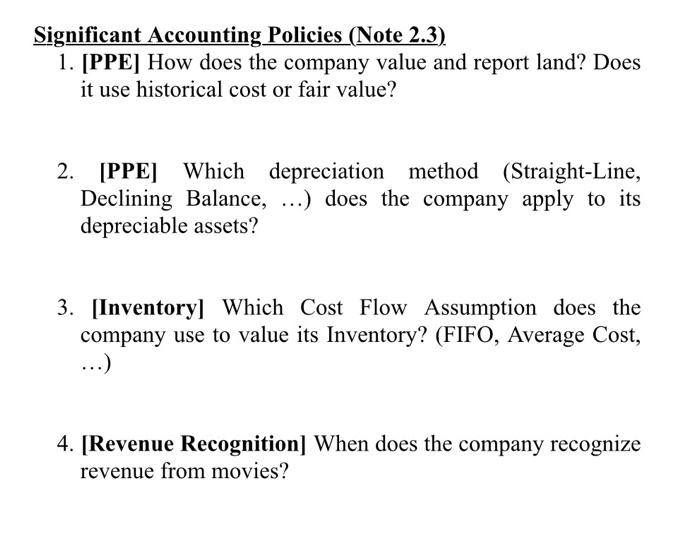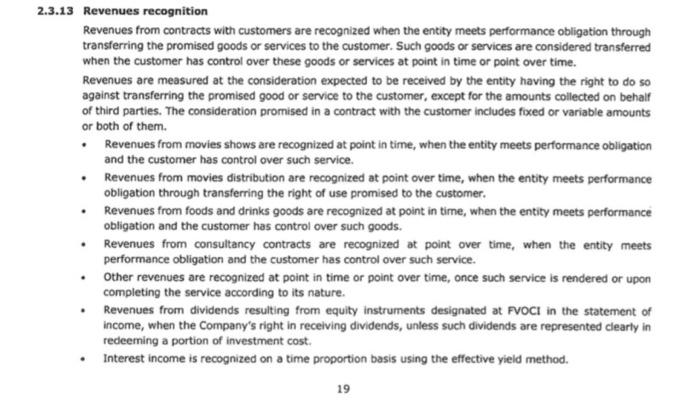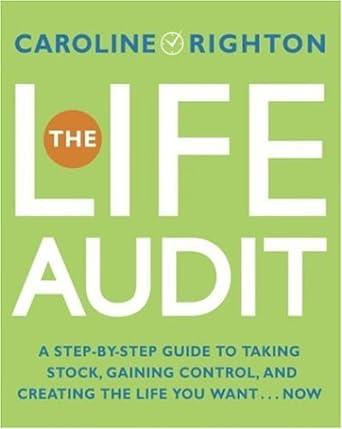Significant Accounting Policies (Note 2.3). 1. [PPE] How does the company value and report land? Does it use historical cost or fair value? 2. [PPE] Which depreciation method (Straight-Line, Declining Balance, ...) does the company apply to its depreciable assets? 3. [Inventory] Which Cost Flow Assumption does the company use to value its Inventory? (FIFO, Average Cost, ...) 4. [Revenue Recognition] When does the company recognize revenue from movies? 2.3.3 Property, plant and equipment Property, plant and equipment, other than tonds, are stated at cost less accumulated depreciation and any impairment losses. Cost includes the purchase price and directly associated costs of bringing the asset to a working condition for its intended use. Maintenance, repairs and immaterial renewal are recognized in the consolidated statement of income for the period in which the expenses are incurred. Land is stated at fair value based on periodic valuations by independent real estate experts usually every three to five years or at early periods if significant or volatile change in fair value are experienced. Any valuation increase arising on revaluation of land is recognised directly in equity under revaluation reserve except to the extent that it reverses a revaluation decrease for the same asset previously recognized in the profit or loss, in which case the increase is credited to profit and loss to the extent of the decrease previously expensed. Decline in carrying amount arising as a result of the revaluation is directly charged to the consolidated statement of income to the extent that it exceeds the balance, If any held in the revaluation reserve relating to a previous revaluation on the land. Depreciation is calculated based on estimated useful life of the applicable assets except for the lands on a straight line basis. The carrying amount is written down immediately to its recoverable amount if the carrying amount of Property, plant and equipment is greater than its estimated recoverable amount The assets' residual values, useful lives and depreciation method are reviewed at the end of each reporting period, with the effect of any changes in estimate accounted basis. Gains or losses on disposals are determined by the difference between the sales proceeds and the carrying amount of the asset and is recognized in the consolidated statement of income. Projects under construction are included in property, plant and equipment until they are completed and ready for their intended use. At that time they are reclassified under the appropriate category of assets and the depreciation is calculated since then. 2.3.8 Inventories Inventories are valued at the lower of cost or net realisable value. Cost is determined on a weighted average cost basis. Net realizable value is determined based on the estimated selling prices less all the estimated costs of completion and costs necessary to make the sale. 2.3.13 Revenues recognition Revenues from contracts with customers are recognized when the entity meets performance obligation through transferring the promised goods or services to the customer. Such goods or services are considered transferred when the customer has control over these goods or services at point in time or point over time. Revenues are measured at the consideration expected to be received by the entity having the right to do so against transferring the promised good or service to the customer, except for the amounts collected on behalf of third parties. The consideration promised in a contract with the customer includes fixed or variable amounts or both of them. Revenues from movies shows are recognized at point in time, when the entity meets performance obligation and the customer has control over such service. Revenues from movies distribution are recognized at point over time, when the entity meets performance obligation through transferring the right of use promised to the customer. Revenues from foods and drinks goods are recognized at point in time, when the entity meets performance obligation and the customer has control over such goods. Revenues from consultancy contracts are recognized at point over time, when the entity meets performance obligation and the customer has control over such service. Other revenues are recognized at point in time or point over time, once such service is rendered or upon completing the service according to its nature. Revenues from dividends resulting from equity instruments designated at FVOCI in the statement of income, when the Company's right in receiving dividends, unless such dividends are represented clearly in redeeming a portion of investment cost. Interest income is recognized on a time proportion basis using the effective yield method. 19










